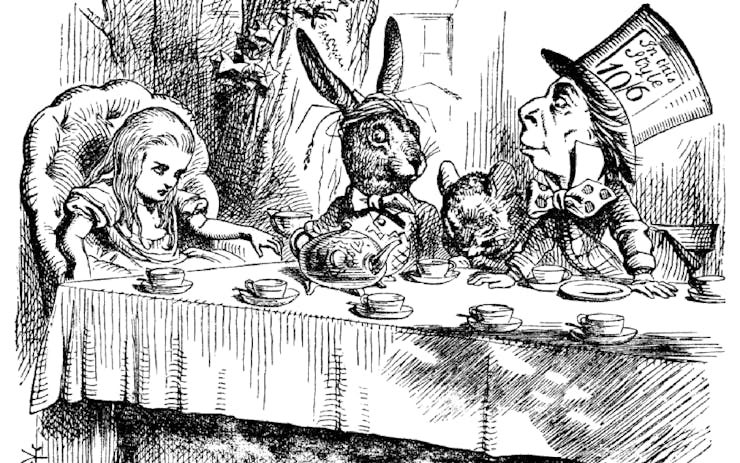Psychedelia has had many influences in literature and pop culture throughout history. However, long before Ken Kesey took Tom Wolfe along for a ride with the Merry Pranksters in The Electric Kool-Aid Acid Test, an English mathematician named Lewis Carroll concocted a story for three little girls while they rowed along the River Thames on a cool summer day.
Carroll, of course, is the author and creator of the magical daydream known as Alice’s Adventures in Wonderland, one of the most beloved pieces of children’s literature that exists today. But did one of our childhood favorites get influenced by our favorite plant? Let’s take a closer look at the influences (chemical or otherwise) that may have shaped Carroll’s trip down the rabbit hole.
On the “golden afternoon” of July 4, 1862, Charles Lutwidge Dodgson (the given name of Lewis Carroll) and the Reverend Robinson Duckworth took a ride in a rowboat upon the River Thames with the three young daughters (one of whom was indeed named Alice) of Henry Liddel, Vice Chancellor of Oxford University. Dodgson told the tale of a bored little girl named Alice who goes off seeking an adventure.
The story may have originated innocently enough, but as Dodgson began expanding and embellishing the details of the tale while writing the manuscript under the pseudonym Lewis Carroll in 1865, the hazy influences of his extracurricular activities emerged in his prose.
One theory as to what influenced the colorful and unusual hallucinatory imagery from Alice’s adventures may have resulted from Dodgson’s migraines, which are well documented in his early journals.
Severe migraines may be accompanied by “auras,” which can be one or many of a variety of symptoms, including blind spots, vision loss, seeing patterns and flashing lights, and seeing, hearing or smelling things that aren’t really there.
A rare type of migraine auras, particularly those with visual and auditory hallucinations, were so commonly associated with the author that the symptoms became known as Alice in Wonderland Syndrome (AIWS). Those who suffer from AIWS often experience size distortion, known as micropsia and macropsia, and they may be confused as to the size and shape of their body or objects around them.
The migraine-induced symptoms, combined with whatever measures Dodgson may have taken to combat these migraines (he was reportedly a fairly heavy cannabis smoker and, according to one source, regularly bought hash oil), could easily have resulted in complex hallucinations that influenced his storytelling.
One of the most quintessential characters from Alice’s Adventures in Wonderland is a hookah-smoking caterpillar that Alice encounters sitting atop a mushroom.
Shop highly rated dispensaries near you
Showing you dispensaries nearWhat substance burns within the hookah? Many who have read the story ponder – was the caterpillar puffing on a bit of cannabis? Or perhaps hashish? It’s not out of the question.
Cannabis was introduced to England from Irish physician William Brooke O’Shaughnessy in 1842 upon his return from a trip to India. O’Shaughnessy was a staunch proponent of the drug for its anti-convulsive properties, and it became popular in medical circles for the treatment of many conditions, including migraine headaches.
The hookah also could have contained opium, which saw a surge of popularity in Victorian England, where opium dens were common until the Pharmacy Act restricted opium sales in 1868. Laudanum, an opium tincture, was commonly available through Victorian pharmacists and often prescribed for pain.
Perhaps more telling is the original illustration by John Tenniel, which shows the hookah-smoking Caterpillar surrounded by flowers from a tobacco plant, a quiet indication that perhaps the hookah’s contents are something as simple as tobacco.
As Alice converses with the ever-puffing Caterpillar, he advises her that if she eats from one side of the mushroom upon which he sits, she will grow taller; eat from the other side and she will grow smaller. This may or may not be a reference to the psychedelic properties that come from the ingestion of certain types of mushrooms, but nevertheless, Alice breaks off a piece of both sides of the mushroom and alters her size with each bite. Alice’s continued growing and shrinking points to Dodgson’s migraine auras, but there’s no denying the clear correlation between Alice eating the mushroom and the effect it has on her.
Another unusual contender for Dodgson’s chemical influences also has chimeric roots in psychedelia. In 1865, it was fairly common to treat severe migraines with ergot. Ergot is a fungus that commonly grows on rye and contains high concentrations of alkaloid ergotamine, a complex molecule with linkage to lysergic acid. Lysergic acid is a molecular precursor to the more commonly known psychedelic drug LSD, and may also induce hallucinations in its users.
Therefore, it’s not completely out of the question to wonder if Dodgson’s extraordinary prose was, in fact, influenced by mind-altering substances, as many have speculated over the years.
Were Alice’s adventures born from mild hallucinations or a vivid imagination? The truth is lost to history, but if you’re feeling curiouser and curiouser, pick up a copy of Alice’s Adventures in Wonderland and Through the Looking Glass, and What Alice Found There, and decide for yourself.







